材料科学工程基础_余永宁_第九章
北京科技大学材科基考研(名词解释汇总及课后重要习题)
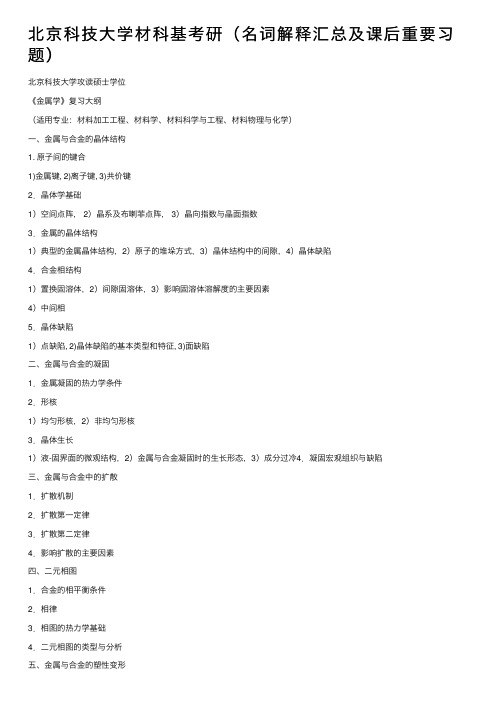
北京科技⼤学材科基考研(名词解释汇总及课后重要习题)北京科技⼤学攻读硕⼠学位《⾦属学》复习⼤纲(适⽤专业:材料加⼯⼯程、材料学、材料科学与⼯程、材料物理与化学)⼀、⾦属与合⾦的晶体结构1. 原⼦间的键合1)⾦属键, 2)离⼦键, 3)共价键2.晶体学基础1)空间点阵, 2)晶系及布喇菲点阵, 3)晶向指数与晶⾯指数3.⾦属的晶体结构1)典型的⾦属晶体结构,2)原⼦的堆垛⽅式,3)晶体结构中的间隙,4)晶体缺陷4.合⾦相结构1)置换固溶体,2)间隙固溶体,3)影响固溶体溶解度的主要因素4)中间相5.晶体缺陷1)点缺陷, 2)晶体缺陷的基本类型和特征, 3)⾯缺陷⼆、⾦属与合⾦的凝固1.⾦属凝固的热⼒学条件2.形核1)均匀形核,2)⾮均匀形核3.晶体⽣长1)液-固界⾯的微观结构,2)⾦属与合⾦凝固时的⽣长形态,3)成分过冷4.凝固宏观组织与缺陷三、⾦属与合⾦中的扩散1.扩散机制2.扩散第⼀定律3.扩散第⼆定律4.影响扩散的主要因素四、⼆元相图1.合⾦的相平衡条件2.相律3.相图的热⼒学基础4.⼆元相图的类型与分析五、⾦属与合⾦的塑性变形1.单晶体的塑性变形1)滑移,2)临界分切应⼒,3)孪⽣,4)纽折2.多晶体的塑性变形1)多晶体塑性变形的特点,2)晶界的影响,3.塑性变形对组织与性能的影响1)屈服现象,2)应⼒-应变曲线及加⼯硬化现象,3)形变织构等六、回复和再结晶1.回复和再结晶的基本概念2.冷变形⾦属在加热过程中的组织与性能变化3.再结晶动⼒学4.影响再结晶的主要因素5.晶粒正常长⼤和⼆次再结晶七、铁碳相图与铁碳合⾦1.铁碳相图2.铁碳合⾦3.铁碳合⾦在缓慢冷却时组织转变⼋、固态相变1.固态相变的基本特点2.固态相变的分类3.扩散型相变1)合⾦脱溶,2)共析转变,3)调幅分解4.⾮扩散型相变参考书:1.⾦属学(修订版), 宋维锡主编, 冶⾦⼯业出版社,1998;2.材料科学基础, 余永宁主编, ⾼等教育出出版社,2006;3.材料科学基础(第⼆版), 胡赓祥等主编, ⾼等教育出出版社,2006;4.任何⾼等学校材料科学与⼯程专业《⾦属学》或《材料科学基础》教学参考书。
材料科学基础(上海交大)--第9章
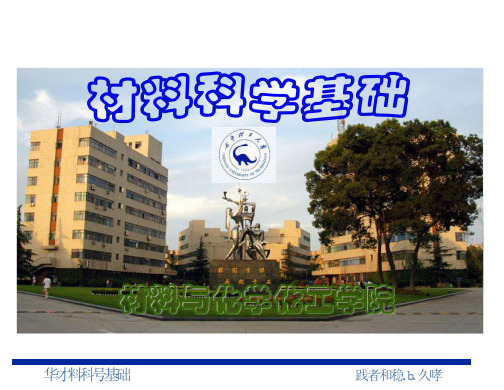
抑制结晶过程而会形成结晶相 ; 冷速过大则准晶的
形核生长也被抑制而形成非晶态。
华 才 料 科 号 基 础
践者和稳.b.久哮
亚稳态的准品在一定条件下会转变为结晶相, 即平衡相。力日热 ( 退火 ) 促使准晶的转变,故准晶 转变是热激活过程,其晶化激活能与原子扩散激活 能相近。但稳态准晶相在加热时不发生结晶化转变, 例如 Al 16Cu 2Fe 为二十面体准晶,在 845 C 长期保温并
留待解决的问题。
华 才 料 科 号 基 础
践者和稳.b.久哮
自20 世纪 80年代以来,随着材料制备新技术的
发展,人们开始研制出晶粒尺寸为纳米
(nm) 级
的材料,并发现这类材料不仅强度更高 ( 但不符合 霍尔一佩奇公式 ) ,其结构和各种性能都具有特殊 性,引起了极大的兴趣和关注。纳米晶材料 ( 或称 纳米结构材料 ) 己成为国际上发展新材料领域中的 一个重要内容,并在材料科学和凝聚态物理学科中 引出了新的研究方向一一纳米材料学。
华 才 料 科 号 基 础
践者和稳.b.久哮
9 . 1 . 1 纳米晶材料的结构
纳米晶材料 ( 纳米结构材料 ) 的概念最早是由
H.Gleiter出 的 , 这 类 固 体 是 由 ( 至 少 在 一个方向上 )
尺寸为几个纳米的结构单元 ( 主要是晶体 ) 所构成。 图9.1 表示纳米晶材料的 二维硬球模型,不同取向的 纳米尺度小晶粒由晶界联结在 一起,由于晶粒极微
在晶化过程中形成大量的晶核而生长成为纳米晶材料。
(2)
形
或造
成局域原子迁移(如高能粒子辐照、火花刻蚀
等 ) 使 之产生高密度缺陷而致自由能升高,转变形成 亚稳态 纳米晶。
华 才 料 科 号 基 础
《材料科学与工程基础》习题和思考题及答桉.doc
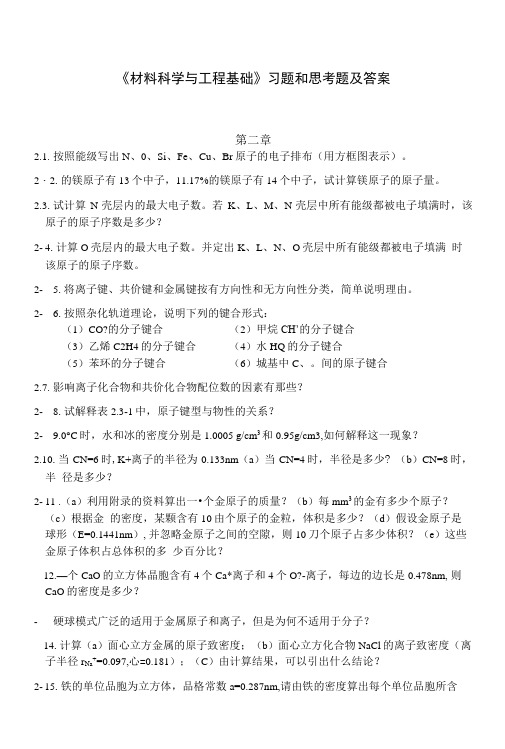
《材料科学与工程基础》习题和思考题及答案第二章2.1.按照能级写出N、0、Si、Fe、Cu、Br原子的电子排布(用方框图表示)。
2・2.的镁原子有13个中子,11.17%的镁原子有14个中子,试计算镁原子的原子量。
2.3.试计算N壳层内的最大电子数。
若K、L、M、N壳层中所有能级都被电子填满时,该原子的原子序数是多少?2-4.计算O壳层内的最大电子数。
并定出K、L、N、O壳层中所有能级都被电子填满时该原子的原子序数。
2-5.将离子键、共价键和金属键按有方向性和无方向性分类,简单说明理由。
2-6.按照杂化轨道理论,说明下列的键合形式:(1)CO?的分子键合(2)甲烷CH’的分子键合(3)乙烯C2H4的分子键合(4)水HQ的分子键合(5)苯环的分子键合(6)城基中C、。
间的原子键合2.7.影响离子化合物和共价化合物配位数的因素有那些?2-8.试解释表2.3-1中,原子键型与物性的关系?2-9.0°C时,水和冰的密度分别是1.0005 g/cm3和0.95g/cm3,如何解释这一现象?2.10.当CN=6时,K+离子的半径为0.133nm(a)当CN=4时,半径是多少? (b)CN=8时,半径是多少?2-11 .(a)利用附录的资料算出一•个金原子的质量?(b)每mm3的金有多少个原子?(c)根据金的密度,某颗含有10由个原子的金粒,体积是多少?(d)假设金原子是球形(E=0.1441nm), 并忽略金原子之间的空隙,则10刀个原子占多少体积?(e)这些金原子体积占总体积的多少百分比?12.—个CaO的立方体晶胞含有4个Ca*离子和4个O?-离子,每边的边长是0.478nm, 则CaO的密度是多少?-硬球模式广泛的适用于金属原子和离子,但是为何不适用于分子?14.计算(a)面心立方金属的原子致密度;(b)面心立方化合物NaCl的离子致密度(离子半径r Na+=0.097,心=0.181);(C)由计算结果,可以引出什么结论?2-15.铁的单位品胞为立方体,品格常数a=0.287nm,请由铁的密度算出每个单位品胞所含的原子个数。
09--《工程材料》第九章
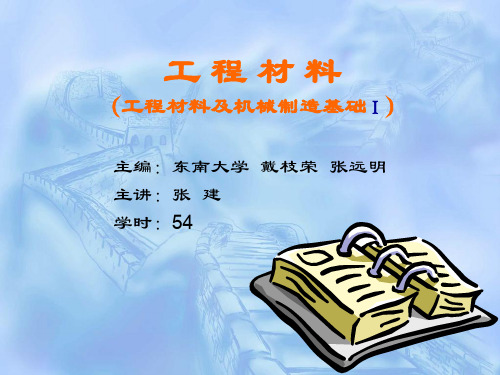
8×××系列表示。 第一位数字:铝合金的组别; 第二 位字母:原始合金的改型情况,“A” 表示原始合金,B-Y为原始合金的改 型合金。最后两位数字:区分同一组 中不同的铝合金。例:5A02。
牌号:X X X X 第一位:数字----表示铝合金的组别 2-------表示Al-Cu 系的铝合金 3-------表示Al-Mn 系的铝合金 4-------表示Al-Si 系的铝合金 5-------表示Al-Mg 系的铝合金 6-------表示Al-Mg+Si系的铝合金 7-------表示Al-Zn 系的铝合金 8-------表示其他元素的铝合金 9-------表示备用合金组 第二位:数字或字母----表示改型情况 A-------表示原始铝合金 B~Y----表示已改型 后两位:数字----区别同一系的不同铝合金
(1)低强度硬铝合金:如LY1~LY10,主要析出θ相, 强度低,塑性高,铆接材料。
(2)中强度硬铝合金:(标准) 如LY11,主要为θ,其 次为S,强度较高,塑性较好, 中等载荷结构件。
(3)高强度硬铝合金:典型LY12,主要为S,其次为θ, 强度较高,良好的耐热性,塑 性较差, 较高载荷结构件。
5A33 5A41 5A43 5A66 5005 7A09 7A10 7A15 7A19 7A31 7A33 7A52 7003 7005 7020 7022 7050 7075 7475 8A06 8011 8090 -
原LF33 原LT41 原LF43 原LT66 - 原LC9 原LC10 曾用LC15、157 曾用919、LC19 曾用183-1 曾用LB733 曾用LC52、5210 原LC12 - - - - - - 原L6 曾用LT98 - -
《材料科学与工程基础》习题和思考题及答案
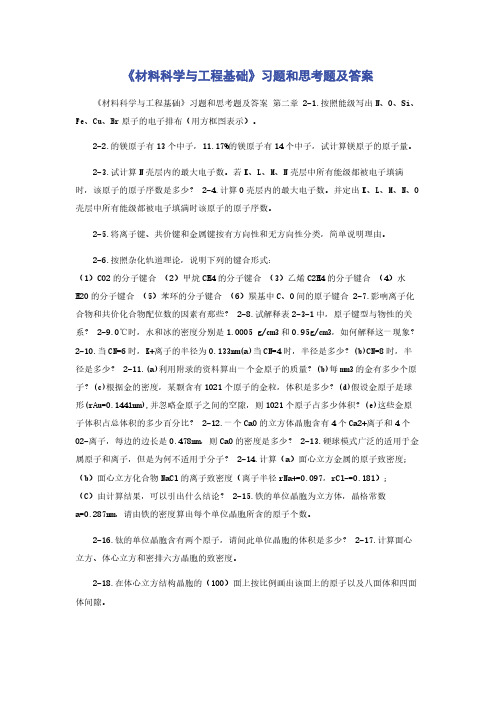
《材料科学与工程基础》习题和思考题及答案《材料科学与工程基础》习题和思考题及答案第二章2-1.按照能级写出N、O、Si、Fe、Cu、Br原子的电子排布(用方框图表示)。
2-2.的镁原子有13个中子,11.17%的镁原子有14个中子,试计算镁原子的原子量。
2-3.试计算N壳层内的最大电子数。
若K、L、M、N壳层中所有能级都被电子填满时,该原子的原子序数是多少?2-4.计算O壳层内的最大电子数。
并定出K、L、M、N、O 壳层中所有能级都被电子填满时该原子的原子序数。
2-5.将离子键、共价键和金属键按有方向性和无方向性分类,简单说明理由。
2-6.按照杂化轨道理论,说明下列的键合形式:(1)CO2的分子键合(2)甲烷CH4的分子键合(3)乙烯C2H4的分子键合(4)水H2O的分子键合(5)苯环的分子键合(6)羰基中C、O间的原子键合2-7.影响离子化合物和共价化合物配位数的因素有那些?2-8.试解释表2-3-1中,原子键型与物性的关系?2-9.0℃时,水和冰的密度分别是1.0005g/cm3和0.95g/cm3,如何解释这一现象?2-10.当CN=6时,K+离子的半径为0.133nm(a)当CN=4时,半径是多少?(b)CN=8时,半径是多少?2-11.(a)利用附录的资料算出一个金原子的质量?(b)每mm3的金有多少个原子?(c)根据金的密度,某颗含有1021个原子的金粒,体积是多少?(d)假设金原子是球形(rAu=0.1441nm),并忽略金原子之间的空隙,则1021个原子占多少体积?(e)这些金原子体积占总体积的多少百分比?2-12.一个CaO的立方体晶胞含有4个Ca2+离子和4个O2-离子,每边的边长是0.478nm,则CaO的密度是多少?2-13.硬球模式广泛的适用于金属原子和离子,但是为何不适用于分子?2-14.计算(a)面心立方金属的原子致密度;(b)面心立方化合物NaCl的离子致密度(离子半径rNa+=0.097,rCl-=0.181);(C)由计算结果,可以引出什么结论?2-15.铁的单位晶胞为立方体,晶格常数a=0.287nm,请由铁的密度算出每个单位晶胞所含的原子个数。
材料科学基础 第九章材料科学基础 第九章
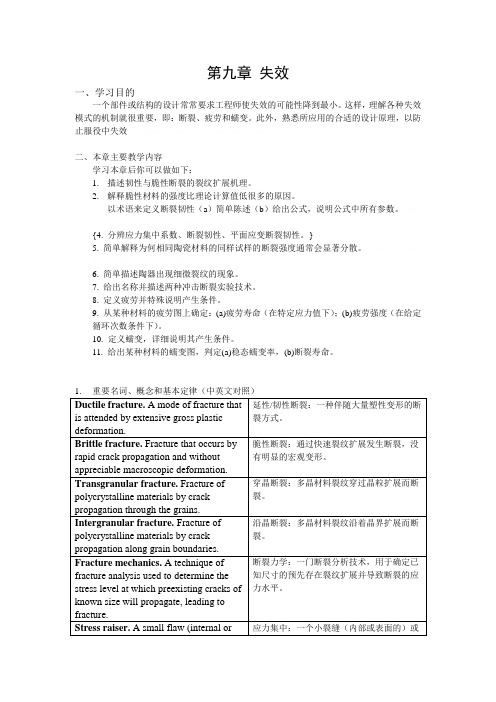
第九章失效一、学习目的一个部件或结构的设计常常要求工程师使失效的可能性降到最小。
这样,理解各种失效模式的机制就很重要,即:断裂、疲劳和蠕变。
此外,熟悉所应用的合适的设计原理,以防止服役中失效二、本章主要教学内容学习本章后你可以做如下:1.描述韧性与脆性断裂的裂纹扩展机理。
2.解释脆性材料的强度比理论计算值低很多的原因。
以术语来定义断裂韧性(a)简单陈述(b)给出公式,说明公式中所有参数。
{4. 分辨应力集中系数、断裂韧性、平面应变断裂韧性。
}5. 简单解释为何相同陶瓷材料的同样试样的断裂强度通常会显著分散。
6. 简单描述陶器出现细微裂纹的现象。
7. 给出名称并描述两种冲击断裂实验技术。
8. 定义疲劳并特殊说明产生条件。
9. 从某种材料的疲劳图上确定:(a)疲劳寿命(在特定应力值下);(b)疲劳强度(在给定循环次数条件下)。
10. 定义蠕变,详细说明其产生条件。
11. 给出某种材料的蠕变图,判定(a)稳态蠕变率,(b)断裂寿命。
2.主要例题、习题的分析解答指导举例9.1较大块玻璃承受40 MPa拉力,如果其比表面能和弹性模量为0.3 J/m2和 69 GPa,求不产生断裂的最大表面裂纹长度。
解答:解此题必须用公式9.3,把a作为应变量重组表达式,已知:σ= 40 MPa, γs = 0.3 J/m2, E = 69 GPa ,代入得:设计举例9.1考虑半径为r厚度为t可以用作压力容器的薄壁球罐(图9.5)。
(a)设计球罐要求在由于形成临界尺寸裂纹并随后快速扩展之前球壁材料屈服,这样,球壁的塑性变形可以观察到,球罐内的压力可以在灾难性失效发生前释放掉。
显然,希望材料具有大的临界裂纹长度,以这一准则为基础,把金属合金按类别列表见附录B表B.5,临界裂纹尺寸从最长到最短。
(b)也常应用于压力容器的选择性设计术语为“破坏前泄露”。
利用断裂机制原理,在裂纹快速扩展发生之前,允许裂纹生长穿过整个容器壁厚度。
这样,裂纹将完全穿透容器壁,不会出现灾难性失效,允许通过带压液体泄露进行检测。
材料科学与工程基础实验指导书

3
实验一
普通光学金相显微镜的构造及使用
一、实验目的 1.了解普通光学显微镜的构造,各主要部件及元件的效用。 2.掌握正确的使用操作规程及维护方法。 二、金相显微镜的原理及使用 1.原理 正常人眼看物体时, 最适宜的距离大约在 250mm 左右, 在这一距离眼睛可以很好地区 分物体的细微部分而不易疲劳,这个距离称为“明视距离” 。物体上的两点要能被眼睛分辨 清楚,必须使它们的像落在人眼视网膜的两个不同的感光细胞上,从眼睛的光心到物体两 端所引的两条直线的夹角叫视角,人眼可分辨清楚的最小视角为 2′∼4′,在 250mm 处能分 辨的最小距离约 0.15∼0.30mm。为了增大视角,就在物体与眼睛间置一放大镜,其放大倍 数为:
M =
250 f
f 为放大镜的焦距,从上式可见,f 愈小、M 愈大,但实际上不可能用焦距很短的放大镜 来观察。透镜的曲率半径太小,眼睛所观察 的范围就更小,且象差愈显著,所以放大镜 一般在 20 倍以下, 若要再提高放大倍数以观 察更细微的物体,就必须用显微镜。 显微镜通过物镜及目镜两次放大而得到 倍数较高的放大像。图 1-1 是它的放大原理 图。 若将试样置于物镜下方的焦点 F1 外少 许,则物镜将试样上被观察的物体(以箭头 所指 WS 表示)放大,而在物镜的上方得到 一个倒立的实像 W1S1, 在设计显微镜时就已 安排好使这个实像刚好落在目镜的焦点 F2 以 内,因而再经过目镜放大后,人眼在目镜上 观察时, 在 250mm 的明视距离处, 看到一个 经再次放大的虚像 W2S2。 所以观察到的像是 经物镜和目镜两次放大的结果。总的放大倍 数 M 应为物镜放大倍数 M 物与目镜放大倍数 M 目的乘积,即:
6
5.调整和维护 1)光源的调整 光源的调整包括径向调整与轴向调整,前者的目的是让发光点调到仪器的光学系统的 光轴上;后者主要是让灯丝通过聚光镜后汇聚在孔径光阑上,以得到“平行光照明” 。光源 精确调整好后应达到视野照明最明亮且均匀,视野内无灯丝像。 2)光阑的调整 在金相显微镜的照明系统中常有两个孔径可变的光阑。孔径光阑装在光源聚光透镜之 后,视域光阑装在孔径光阑之后。 (1)孔径光阑 孔径光阑用以控制射向物镜的入射光束的粗细。孔径光阑若开得太大,则入射光过强, 增加了镜筒内部的反射与炫光,降低影像的衬度。缩小孔径光阑可避免上述弊病,且可消 除由透镜边缘引起的球面像差并提高映像的景深。但若孔径光阑缩得太小,光束只通过物 镜的中心部分,使实际的数值孔径减小,使物镜的分辨能力降低。因此,应按观察的要求 适当调节孔径光阑的大小。一般是调到刚好使光线充满物镜的后透镜为宜,此时物镜的分 辨能力最高。有人认为可以将试样调焦后,去掉目镜,观察镜筒内的光斑,以刚好充满镜 筒底部的四分之三为准。一般却是调节到观察时物像最清晰、不产生浮雕,晶界不变形、 不弯曲,光的强弱使人眼舒适为原则。物镜的数值孔径不同,透镜组尺寸也不同,更换物 镜后必须重新调节孔径光阑。 (2)视场光阑 视场光阑用以改变视场大小、减小镜筒内部的反射与炫光以提高映像的衬度而不影响 物镜的分辨能力。视场光阑的调节方法是在显微镜调焦后,缩小视场光阑,在目镜中观察 其像,然后扩大它,使其边缘正好包围整个视物。有时为了观察某一试样的局部细致组织, 也可将视场光阑缩小到刚好包围此局部组织,以收到更好的效果。 总之,孔径光阑与视场光阑,都是为了提高成像质量而加入到光线系统中去的。通过 调节这些光阑可最大限度地利用物镜的鉴别率并得到良好的衬度。 3)维护要点 金相显微镜是精密光学仪器,使用时必须了解其基本原理及操作规程,要认真维护、 保管,细心谨慎使用。 (1)操作显微镜时双手及样品干净,绝不允许把侵蚀剂未干的试样在显微镜下观察, 以免腐蚀物镜。 (2)操作时应精力集中,小心谨慎。接电源时应通过变压器,装卸或调换镜头时必须 放稳后才可松手,不可粗心大意。 (3)调焦距时,应先转动粗调螺丝,使物镜尽量接近试样(目测) ,然后一边从目镜 中观察,一边调节粗调螺丝使物镜慢慢上升直到逐渐看到组织时,再用微调螺丝调至清晰 为止。 (4)显微镜的光学系统部分严禁用手或手帕等去擦,而必须用专用的驼毛刷或镜头纸 轻轻擦试。 (5)使用过程中,若发生故障,应立即报告老师,不得自行拆动。
2019年华中科技光电国家实验室考研复试时间复试内容复试流程复试资料及经验
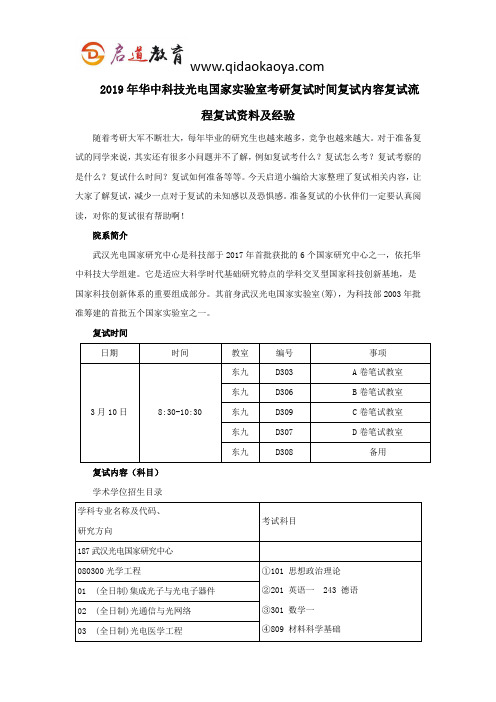
2019年华中科技光电国家实验室考研复试时间复试内容复试流程复试资料及经验随着考研大军不断壮大,每年毕业的研究生也越来越多,竞争也越来越大。
对于准备复试的同学来说,其实还有很多小问题并不了解,例如复试考什么?复试怎么考?复试考察的是什么?复试什么时间?复试如何准备等等。
今天启道小编给大家整理了复试相关内容,让大家了解复试,减少一点对于复试的未知感以及恐惧感。
准备复试的小伙伴们一定要认真阅读,对你的复试很有帮助啊!院系简介武汉光电国家研究中心是科技部于2017年首批获批的6个国家研究中心之一,依托华中科技大学组建。
它是适应大科学时代基础研究特点的学科交叉型国家科技创新基地,是国家科技创新体系的重要组成部分。
其前身武汉光电国家实验室(筹),为科技部2003年批准筹建的首批五个国家实验室之一。
复试时间复试内容(科目)学术学位招生目录专业学位招生目录复试分数线复试流程(一) 专业笔试 (占复试总成绩的40%)1. 报考计算机系统结构和计算机技术专业的研究生参照计算机科学与技术学院复试细则,并参加计算机科学与技术学院组织的笔试、上机测试和英语测试(具体见计算机科学与技术学院官网通知)。
2. 报考光学工程、电子科学与技术、信息与通信工程、电子与通信工程专业的研究生,报到时从以下A、B、C试卷中任选一份。
(1)A卷考试科目:考生可从《物理光学与应用光学》《光纤通信技术》《信号与系统》《半导体光电子学》四门课程中任选两门,每门课程50分,满分为100分,考试时间为120分钟。
参考书目:1) 物理光学参考书:《物理光学》竺子民,华中科技大学出版社;《物理光学》梁铨廷,电子工业出版社(第四版);2) 应用光学:《应用光学》张以谟,电子工业出版社(第三版);3) 信号与系统:《信号与系统》奥本海姆,电子工业出版社(第二版);4) 半导体光电子学:《半导体光电子学》黄德修,电子工业出版社(第二版);5) 光纤通信技术:《Fiber-optic communication systems 》G.P.Agrawal,Wiely-interscience,2001年(第三版)。
材料科学基础第9章
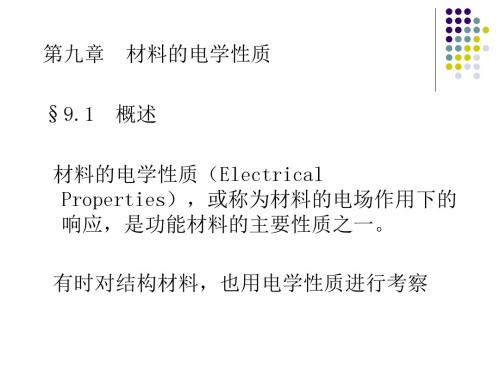
载流子密度n—单位体积内的载流子数目, 载流子的迁移率(mobility)—载流子在 单位电场作用下,单位时间内沿电场方向 (带正电的载流子)或沿电场的相反方向 (带负电的载流子)迁移的距离。 迁移率的单位为m2/(V· s)
联系电导率宏观物理量和迁移率、载流子 数目等微观物理量,有: =n ·|q| · q为载流子的电荷电量
式中, t, i, d 分别表示温度、杂质、 形变 对电阻率的贡献
1) 温度的影响: 对大多数金属和合金,有
t 20 (1 T )
式中, 为电阻率温度系数,大多数金属的几 乎相等,为410-3/ º C T=(t-20) º C
2) 杂质的影响 一般掺杂会使电阻率升高
3)形变的影响
A为垂直于电流方向的截面积,单位为squaremeters(m2) 为电阻率(resistivity),单位为Ohms-meters (•m)
§9.2.2 电导率( Electrical Conductivity)
电导率(Electrical Conductivity)常用符号 为,国际单位为S/m:
如Fe, Al, Ag的IACS分别为17%, 61%, 106%
固体中导电传导电荷的载流子(carrier)的种 类是不同的,可以是电子、空穴、正离子、负离 子。都遵守欧姆定律。 注意Ohms Law的微分形式为:
J E
J为电流密度(current density), E为电场强度(electric field intensity)
一般形变会ห้องสมุดไป่ตู้电阻率升高
§9.2.4 半导体电子的电导率
半导体(semiconductor)可以分为 本征半导体(Intrinsic semiconductor)和非 本征半导体(Extrinsic semiconductor)
材料科学与工程基础.doc

二、常见纯金属的晶格类型(理想纯)(一)体心立方晶格(bcc boady centerad cube)常见金属>30种之多(例如α-Fe、Cr、Mo、W、V、Nb)(√2a)2+a24r2 2 a2+a242r2 3 a24r2∴r√3/4a晶胞原子数1/8812个配位数8 ABABABAB。
不同的堆集方式有不同的空间点阵,即各自具有代表性的空间单元亦不同,即晶胞不同。
e、晶胞各边的尺寸a、b、c称为晶体常数。
晶胞棱间夹角用α、β、γ表示。
见图24 z y x a简单立方晶体(b)晶格(c)晶胞(二)晶系不同元素的原子在一定条件下对应某种晶格。
当条件变化到另外某种状态(T-P-)时,又可转变成(对应于)另外的晶格。
。
。
。
致密度K 24/3πr3(图25 bcc)a3二面心立方晶格(FCC face centered cube)晶格常数亦只用一个a表示。
显而易见r/4a晶胞的原子数1/881/264个配位数12 ABCABCABC。
。
。
可算出致密度为0.74(图26 FCC)属于这种晶格的金属有r-Fe、Ni、Al、Cu、Pb、Au、Rh等>20种。
1、金属材料金属材料的结合键主要是金属键;但金属材料中的金属间化合物是离子键。
书中提及的灰锡(共价键)已不能用做工程材料,此类状态已失去了金属性能。
2、陶瓷材料离子键为主,亦有共价键。
所以,陶瓷材料硬度高,熔点高,脆性大。
3、高分子材料共价键和分子键。
高分子材料分子大的特点,决定了其分子之间的作用力大,性能好。
(例如玻璃等)
一、晶体的基本概念(一)晶格和晶胞(表示方法)抽象法(抽象晶体)a、将原子视为球形,它们的堆砌集可有不同的规律(多样性)。
清华大学材料科学基础目录及第一章题解

《金属学原理》习题解答北京科技大学余永宁目录第一章.晶体学 3 第二章.晶体结构19 第三章.相图22 第四章.金属和合金中的扩散45 第五章.凝固56 第六章.位错65 第七章.晶态固体的表面和界面79 第八章.晶体的塑性形变86 第九章.回复和再结晶92 第十章.固态转变98第1章1. 把图1-55的图案抽象出一个平面点阵。
解:按照等同点的原则,右图(图1-55)黑线勾画出的点阵就是由此图案抽象出的平面点阵。
2. 图1-56的晶体结构中包含两类原子,把这个晶体结构抽象出空间点阵,画出其中一个结构基元。
解:下右图(图1-56)的结构单元是由一个黑点和一个白点组成,按照等同点原则,抽象除的空间点阵如下左图所示,它的布拉喇菲点阵是面心立方。
3. 在图1-57的平面点阵中,指出哪些矢量对是初基矢量对。
请在它上面再画出三个不同的初基矢量对。
解:根据初基矢量的定义,由它们组成的平面初基单胞只含一个阵点,右图(图1-57)中的①和②是初基矢量对,③不是初基矢量对。
右图的黑粗线矢量对,即④、⑤和⑥是新加的初基矢量对。
4. 用图1-58a 中所标的a 1和a 2初基矢量来写出r 1,r 2,r 3和r 4的平移矢量的矢量式。
用图1-58b 中所标的初基矢量a 1,a 2和a 3来写出图中的r 矢量的矢量式。
解:右图(图1-58)a 中的a 1和a 2表示图中的各矢量:r 1=a 1+2a 2 r 2=-2a 2 r 3=-5a 1-2a 2 r 4=2a 1-a 2右图b 中的a 1、a 2和a 3表示图中的r 矢量: r =-a 1+a 2+a 35. 用矩阵乘法求出乘积{2[100]⋅4[001]}的等价操作,再求{4[001]⋅2[100]}的等价操作,这些结果说明什么? 解:因−−=100010001}2{]100[−=100001010}4{]001[{2[100]⋅4[001]}的等价操作为−−−= −⋅−−=⋅100001010100001010100010001}4{}2{]001[]100[这组合的操作和}2]011[{操作等效。
工程材料科学与基础-余永宁-答案

Chapter 6 - Problem Solutions1. FIND: Compare the structure of a glass to that of the liquid.GIVEN: Both are noncrystalline.SOLUTION: The structure of a glass is essentially that of a frozen liquid.There is SRO but no LRO. Since the glass is at a lower temperature than the liquid of the same composition and most materials contrast as they are cooled, the density of the glass is usually less than that of the liquid. The density ofthe glass is usually considerably greater than that of the crystal, however.Density is mass per unit volume, and the units we see most often are g/cm3.The most common units of reciprocal density are cm3/g. This is volume per unit mass, or specific volume. It is frequently used by chemical physicists,who study noncrystalline materials.2.3. FIND:How does C p of an amorphous material change as the temperature isincreased through the glass transition temperature?SOLUTION:Heat capacity is an intensive property, one that does dependon the bulk properties of the material. Most thermodynamic intensiveproperties behave exactly the same as (molar) volume in the vicinity of theglass transition temperature. Hence, heat capacity changes slope through the T g.4.5. FIND:Estimate the volume thermal expansion coefficient of a glass.GIVEN:Its linear thermal expansion coefficient in the melt is 10 x 10-6 o C-1.ASSUMPTIONS:The material behaves typically, so that the thermalexpansion coefficient of the glass is about 1/3 of that of the melt.SOLUTION:The linear thermal expansion coefficient is αth and thevolumetric thermal expansion coefficient is αv.αth(glass) ≈αth(melt)/3 and αv(glass) ≈ 3αth(glass) Hence,αv(glass) ≈ 3αth(melt) = 10 x 10-6 o C-16. FIND:Derive the relationship between αth and αv: αth/αv = 1/3SOLUTION:consider a cube of materials, length 1 on a side. With heat,the materials expands isotropically to length 1+δ1. We do the problem firstusing differentials.1 / 13Now with deltas: V = (ι + δι)3 = 13 + 3ι2δι + ...⇒∆V ≈ 3ι2δι. Therefore, 9. FIND:Is T g a temperature or range of temperatures?SOLUTION:Although we often cite a glass transition temperature, theglass transition occurs over a range of temperatures. T g is rate sensitive andstructure sensitive; it depends on the rate of heating or cooling and on thelocal structure which is statistically variable in a glass or melt.10. FIND:The temperature range for transitions that involve units smaller than amer.SKETCH:SOLUTION:In a polymer, the repeat unit is a mer. If the repeat unit gains mobility, then the entire molecule and all of its parts are mobile. It requiresless thermal input, kT, to excite smaller units, such as rotation of the ring sidegroup in the polystyrene shown in the figure. Hence, such transition are sub-T g.COMMENTS:Transitions in the crystalline regions can occur above T g and below T m.11. FIND: Design a rubber gasket for use in outer space.GIVEN: Outer space can fluctuate between cold and hot, and the atmosphere depends on the location in space. Solar radiation is very strong in space.ASSUMPTIONS: We'll design for space being a vacuum.SOLUTION: Fortunately the seal will probably never see solar radiation, sothis is not a design problem. That is fortunate, since flexible materials(polymers) do not stand up to radiation. (Look at what happens to your skinwhen you expose it to bright sunshine.) Temperature can also be a problem.High temperatures can soften, melt or degrade polymers. Low temperaturecan change a rubber to a glass, making a material that is flexible at roomtemperature to brittle at high temperature. Rubber seals that have becomeglassy may break or leak. Metal seals will decrease in volume as thetemperature is decreased. If your choice is a rubber gasket, then it needs toremain flexible at use temperature. Liquid oxygen is very cold and embrittles many materials.2 / 1312. FIND: Provide examples of materials that behave like silly putty.GIVEN: Silly putty is used at a temperature that it sometimes behaves in a fluid-like manner and sometimes in a solid-like manner.SOLUTION: There are many such examples, but they are sometimes hard toidentify. Consider these materials:1. Plumbers putty2. Rubber mounts for car engines and vibrating machines3. Rubber bumpers4. Water. (Consider jumping off a 100 foot cliff into a water-filled quarry)5. Bullet-proof vest (Textile-like in ordinary use and bullet-proof when necessary)COMMENTS: For a number of applications we need materials with similarbut different properties - a material that flows under low stress but does notflow under its own weight (Bingham plastic). Plumbers putty is an example, but it also shows the characteristics of silly putty.13. FIND: Is it unique that motor oils do not thin with increasing temperature?SOLUTION: Recall equation 6.3-5b:η= ηo exp (Q/RT).This equation tells you that as temperature increases, viscosity decreasesexponentially. If motor oil does not behave this way, then it behaves in anunusual manner.COMMENTS: Motor oil, in fact, does behave in an unusual manner. It'sviscosity is essentially constant with temperature! Let me try to explain howthis is accomplished. Oil contains polymer molecules in a solvent. Themolecules do not like the solvent all that much, so they tend to ball up or coilsomewhat tightly on themselves. As the temperature is increased, theinteraction between solvent and polymer changes. The polymer begins to like the solvent, so it uncoils. The polymer molecules then become entangled inone another, raising the viscosity, which counteracts the normal decrease withincreasing temperature.14. FIND:Whether it is more difficult to obtain a GIVEN: shear strain rate witha high viscosity fluid or a low viscosity fluid.ASSUMPTIONS:The oils behave in a similar fashion in a stress field.SKETCH:SOLUTION:Newton’s Law of Viscosity states that shear stress isproportional to velocity gradient. The constant of proportionality is viscosity:τ = η(dv/dx). Since the velocity gradient is invariant in this problem, the3 / 13shear stress varies with viscosity. The higher viscosity oil will require alarger stress to maintain the plate velocity. Skotch® tape is a polymer filmwith a thin coating of an oil-like material. It is simply the thinness of the oilfilm and its viscosity that prevents slippage between substrate and film.COMMENTS: When a large stress is required to shear a fluid, then muchwork is lost so that heat is generated in the fluid.15. FIND: Explain how viscosity changes as a material is crystallized or solidifies as a glass.SOLUTION: Let us first consider what occurs when a material like molasses or honey is cooled. As cooling proceeds, the material gets "thicker and thicker".Technically, we mean that the viscosity decreases with temperature. Eventually the material is so hard that we say it is frozen. What we mean really is that we are below the glass transition temperature. Thus, viscosity decreases manyorders of magnitude as molasses, or any materials that does not crystallize, iscooled from the fluid-like state to the rock-hard state. Now consider a material that crystallizes, say, water, since we are all familiar with it. As water is cooled, it changes viscosity very little. At 0︒C both water and ice coexist. Below 0︒C only ice exists. Thus, the viscosity of H2O changes orders of magnitude at 0︒C.Unlike materials that do not crystallize, viscosity changes orders of magnitude over a very narrow temperature range - less than a degree.16. FIND: Show the atactic and isotactic configurations of PP. Which is morelikely to be semicrystalline?GIVEN: The structure of PP is shown in Table 6.4-1. The structure ofatactic and isotactic polymer is shown in Fig. 6.4-5.SKETCH: i-PP has the methyl groups all on the same side. (The H sidegroups are not shown, but each carbon is bonded to 4 atoms. You shouldmentally visualize all the H atoms.)C C C C CCH3CH3CH333a-PP has the methyl groups appearing randomly on one side or the other.C CCC CCC33CH33CH3SOLUTION: Since the methyl groups, which are large and bulky, are all on the same side in i-PP, the molecules can be efficiently packed together (when the molecules are stretched out). Hence, i-PP is semicrystalline. It mechanical properties are generally good up to about the melting temperature, 160︒C. a-PP is noncrystalline, since the molecules cannot be packed together into a unit cell. It's properties are limited by its glass transition temperature, which is about 0︒C. COMMENTS: A-PP is a useless gummy substance. All the PP in use today is i-PP. It is used in huge quantities.4 / 1317. FIND:Show the stereo isomers of PAN.GIVEN::PAN is poly(vinyl cyanide).5 / 13SKETCH: (H are not shown)isotacticsyndiotacticatacticCOMMENTS: Commercially available PAN is atactic.18. FIND: Which polymer is more likely to be semicrystalline, PVdF (which has 2F's) or PVF (a vinyl polymer, which has 1 F)?SOLUTION: Note that the PVdF [poly(vinylidene fluoride)] is symmetric.Symmetric molecules are easier to pack than nonsymmetric ones. PVdF issemicrystalline. PVF, like PVC, is noncrystalline.19. FIND: Estimate the glass transition temperature of PET.GIVEN: It's melting temperature is about 255︒C = 528K.SOLUTION: The melting temperature of nonsymmetric polymers is about 2/3 T m, when the melting temperature is in absolute degrees. Hence, T g≈2/3 x 528K = 353K = 79︒C.COMMENTS: The T g of PET is up to 40︒C higher than 80︒C, depending onthe specific polymer characteristics.20. FIND:Calculate the number of mers or degree of polymerization is a sampleof PP with a molecular weight of 150,000 g/mole.DATA:PP is a vinyl polymer with a methyl side group.SOLUTION: There are 3 C and 6 H per repeat unit ⇒ MW = 3 x 12 + 6 x 1 = 42 g/mer. Hence, number of mers = 150,000 g/mole / 42 g/mole of mers = 3571 mers.COMMENTS:We always ignore chain end groups in these sorts ofcalculations because the effect is negligible.21. FIND: Calculate the MW of a cellulose mer. If a molecule of cotton has aMW of 9,000 g/mole, how many mers are joined?GIVEN:The structure of cellulose is shown in Fig. 6.4-3a.DATA: According to Appendix A, the atomic weight of C is 12.01, H 1.01,and O 16.00 g/mole.SOLUTION: Count the number of atoms of each type per mer: 10 O, 12 C,and 8 H. Thus, the MW of a mer is 10 x 16 + 12 x 12.01 + 8 x 1.01 = 312.206 / 13g/mole. A molecule of cotton with a MW of 9,000 g/mole has 9,000 g/mole / 312.2 g/mole 29 mers joined.COMMENTS: This is a typical MW of cotton, 9,000 g/mole. It is formedby joining only about 29 mers.22. FIND:How will the addition of pentaerythritol affect the crystallinity andglass transition temperature of PET?GIVEN:Pentaerythritol is tetra functional.SOLUTION:Any branching agent will disrupt the ability of the moleculesto pack efficiently. Hence, crystallinity or the potential for crystallinity willbe reduced. Crosslinking makes molecular motion more difficult, so it raisesthe glass transition temperature.23. FIND:How does radiation that cleaves covalent bonds effect crystallinity?SOLUTION: Order must be perfect or near perfect in order to have a crystal.Cleaving bonds in crystals destroys the balance of order. Some bonds arebroken, creating a difference in the bond arrangement than exists in the virgincrystal.COMMENTS:Organic molecules form crystals readily under appropriateconditions, but the structure of the crystal and the unit cell parameters do notresemble those of similar polymers.24. FIND: Does the fact that PP, crystallized under quiescent conditions, ischaracterized by Maltese cross patterned spherulites that fill the entire sampleimply 100% crystallinity?SOLUTION:Spherulites are aggregates of crystalline and noncrystallinematerial. Thus, a completely spherulitic sample is semicrystalline.25. FIND:Explain why amorphous PET that is hot stretched becomes opaqueand slowly cold drawn amorphous PET may remain transparent.DATA:The glass transition temperature of PET is about 100o C.SOLUTION:Stretching a limited extent at room temperature does notinduce crystallization in PET, whereas stretching above T g and orienting themore mobile molecules into a position similar to those occupied by themolecules in a crystal likely induces crystallization.COMMENTS:In making a very strong PET fiber it is necessary to orientthe molecules at first without inducing crystallization. Subsequent drawingsteps are typically carried out at progressively higher temperatures.26. FIND: How many O are in a mer of cellulose?GIVEN: The structure of cellulose is shown in Fig. 6.4-3a.SOLUTION: Count the O: There are 2 in the ether positions, connecting therings; there are 3 as OH groups on each of the 2 rings; and there is one aspart of each of the 2 rings. Add them up: 2 + 2 x 3 + 1 x 2 = 10 O per mer.COMMENTS: They are extremely important in providing cellulose its properties!7 / 1327. FIND: Why are CaO and Na2O added to SiO2 in most applications for silicate glasses?SOLUTION: According to Table 6.5-1, neither CaO nor Na2O are glass forming systems. Rather, they are network modifiers, as stated in Table 6.5-2. Theyloosen the silicate network, lowering the glass transition temperature significantly.Thus, they are added to silica to reduce the cost of raw materials and, moreimportantly, the cost of processing.COMMENTS: The T g of silica in on the order of 1000︒C and that of soda-lime -silicate can be on the order of 500︒C.28. FIND:Is lead oxide a good glass former?SOLUTION:Zachariasen’s rules state that the metal should have acoordination number of 3 or 4. The valence of lead is such the PbO is theoxide predicted. Hence, PbO is not a good glass former. It is anintermediate.29. FIND: Are epoxies and thermoset polyesters semicrystalline or noncrystalline?GIVEN: Both are highly crosslinked, transparent, hard and brittle.SOLUTION: Highly crosslinked polymers are always noncrystalline andbelow T g at room temperature. They are glasses. The crosslinks preventcrystallization.COMMENTS: On of the problems with some composite matrices is that theyare brittle and not tough. Thermoplastic matrices are being developed forvarious demanding applications. High molecular weight thermoplastics,which are semicrystalline polymers, have high viscosity. It is difficult to getthem to flow into the spaces between fibers.30. FIND: How can you detect when a glassy metal crystallizes?SOLUTION: Heat is released when crystallization occurs. If the metal werelike a coin in your pocket, it might burn you. Use a calorimeter to quantifythe effect. X-ray diffraction will also show when crystallization occurs. Thedensity or specific volume of the material changes with crystallization.COMMENTS: Many other techniques can also be used to detect crystallization.31. FIND:Will mixtures, actually solutions, of PbO and SiO2 be good glass formers?GIVEN:SiO2is a good glass former; PbO is not.SOLUTION:Since they form a solution, we expect the solution, which iseven more complex than either component, to be even slower to crystallize.Thus, PbO-SiO2mixtures should be excellent glass formers so long as thePbO content is not high.32.33. FIND:Explain the role of B and Si in Metglas®.GIVEN:Metglas® is an iron based amorphous metal alloy.8 / 139 / 13 SOLUTION: The additives hinder crystallization, by increasing theviscosity of the melt, thereby reducing the diffusion coefficient, and byincreasing the size of the unit cell, thereby making it necessary for atoms to move farther to their crystallographic positions.34. FIND: How does modulus change as molecules are aligned along a fiber's axis?GIVEN: A single molecule is bonded by covalent forces. A collection of molecules is boned by both primary and weaker secondary bonds. In a fiber with all molecules aligned along the fiber axis, forces are transmitted along covalent bonds only.SKETCH:M o d u lu sM o le c u la r M is a lig n m e n t a lo n g F ib e r A xisSOLUTION: The figure can best be read by beginning a large values on the abscissa. As the alignment increases, the modulus increases. With near zero misalignment, the molecules are packed together in a parallel fashion and stresses are carried by covalent bonds. The fiber requires a large stress to achieve significant deformation.COMMENTS: Pound for pound, organic fibers with this morphology have better mechanical properties than do metals.35. FIND: What polymer would you select for use as a flexible gasket on a liquidnitrogen tank?GIVEN: Liquid nitrogen boils at a very low temperature.SOLUTION: You need a material that remains flexible even down to liquid nitrogen temperatures and one that does not react with nitrogen. Somesilicone rubbers (thermoset elastomers) are currently used for this application.36.37. FIND: Why is the modulus of Spectra ® PE roughly 30 times greater than thatof sandwich bag PE?GIVEN: Both are PE.SOLUTION: The difference is modulus is chiefly a result of the very high molecular orientation in Spectra ® PE fiber and virtually no molecularorientation in sandwich bag PE.38. FIND: Predict interesting properties of poly(dimethyl siloxane).SKETCH:SOLUTION:The polymer contain no carbon in the backbone. It isinorganic. The methyl side groups preclude crystallization, so the material is amorphous. The molecule is symmetric and its T g is well below roomtemperature. Hence, it is a rubber. Lightly crosslinked, it has excellentelastomeric properties. Because of its chemistry, it is chemically inert inmost environments, as well as stable to moderate temperatures.COMMENTS: A low grade of the materials is sold as RTV silicone rubber.39. FIND:Calculate the end-to-end separation of PS molecules.GIVEN:The DP is 5000DATA: 1 = 1.54ASKETCH:SOLUTION:We use equation 6.6-2: L = [m12(1 + cosθ')]½ toapproximate the end-to-end separation. There are 2 bonds, each 1 = 1.54Aper mer. The backbone is all carbon, so the factor (1 +cosθ')/(1-cosθ') is 2.Substituting gives:L = [2 x 5000 x 1.542 x 2]1/2 = 218ACOMMENTS:This is a lower bound, largely because of the termsneglected in equation 6.6-2. A more sophisticated calculation shows thevalue is about 300A.40. FIND: Calculate the end-to-end separation of 150,000 g/mole a-PS.GIVEN: a-PS does not crystallize. PS is a vinyl polymer with a backbone of all C and a side group, as shown in Fig. 6.4-1.ASSUMPTIONS: The chains have no net molecular orientation. The chain end separation is governed by random flight statistics.DATA: The molecular weight of the mer is 8 x C + 5 x H = 8 x 12.01g/mole + 5 x 1.01 g/mole = 101.13 g/mole. θin equation 6.6-2 is 109.5︒and l is 1.54 A, as shown in Table A as twice the covalent radius of C.SOLUTION: The number of mers in a 150,000 g/mole samples of PS is:10 / 1311 / 13 150,000 g/mole ÷ 101.13 g/mole of mers = 1483 mers.For each mer there are 2 C-C bonds, as shown in Fig. 6.4-1. Equation 6.6-2 can be used to estimate the end-to-end separation: (The molecule will look as is depicted in Fig. 6.6-8b.)end to-end separation = l m A A 1115429661109511095168+-=+-=cos cos .cos .cos .θθ. 41.FIND: Show the change in modulus with temperature for a semicrystalline polymer.GIVEN: T g = 0o C and T m = 160o C.SKETCH:SOLUTION: The modulus will decrease at T g and fall to a very low value at T m .COMMENTS: This is how PP behaves. To lessen the impact of T g , polymer scientists and engineers attempt to increase crystallinity as much as possible.42. FIND: Show how the molecular weight between crosslinks affects themechanical properties of an epoxy.SOLUTION: Increasing the molecular weight between crosslinks is equivalent to decreasing the crosslink density. As the crosslink density decreases, the modulus decreases and the elongation-to-break increases. Strength changes are not straightforward to predict. Usually, strength increases with crosslink density up to a point.COMMENTS: Too high or Too low a crosslink density leads to a mechanically inferior product.43.FIND: How might you make a fiber from crosslinked rubber? from a thermoplastic elastomer?GIVEN: Crosslinked rubber is one molecule. It does not melt and flow. The molecules cannot slide past one another irreversibly. Thermoplastic elastomers have temporary crosslinks. Upon heating, the molecules can slide past one another irreversibly.SOLUTION: It can indeed be difficult to make a fiber from crosslinked rubber. In fact, to make a fiber using latex (natural) rubber, the crosslinkingis induced after fiber formation. Rubber bands, which are essentially thickfibers, are generally not round in cross-section. They are slit sheets, so thefibers are square or rectangular in cross-section. Thermoplastic fiber can bemelt- or solution-formed directly. Lycra is a thermoplastic elastomer.44. FIND:Why do fabrics shrink when washed in hot water?GIVEN:Fiber are composed of aligned polymer molecules.SKETCH:SOLUTION:When heat is applied the aligned molecules seek to crystallize or coil on themselves. When they move to coil, the fiber shrinks.COMMENTS:Most of the shrinkage occurs during the first heat. Hence,the fiber can be heat set to minimize subsequent shrinkage.45. FIND:Explain why the modulus of rubber is much lower than thatcharacteristic of ceramic or oxide glass.SOLUTION:Rubbers are polymers that undergo conformational changes or straightening out of the coiled polymer chains in the fluid-like state with stress.Ceramics and oxide glasses respond to stress by attempting to push or pullatoms out of their energy wells. Conformation changes are much easier toachieve. Rubber elasticity is entropy driven. Hookean elasticity is energydriven.46. FIND:Calculate the end-to-end separation of PP (a) coiled on itself and (b)completely stretched out.GIVEN:The molecular weight is 150,000 g/mole.DATA: 1 = 1.54ASKETCH:SOLUTION:We need to determine the number of bonds in the moleculefor both parts and b. MW molecule/MW mer = number of mers or DP. MW mer =3 x 12 + 6 x 1 = 42 g/mole. Therefore, DP = 150,000/42 = 3571 twice12 / 13that many bonds(a) Using equation 6.6-2,L = [m12(1+cosθ')/(1-cosθ')½ = [2 x 3571 x 1.542 x 2]1/2 = 184A Note that in the hydrocarbon chain the entire cos factor is 2 and that there are 2 bonds per mer in all vinyl polymers.(b) Using equation 6.6-1,L ext = mlcos(θ/s) = 2 x 3571 x 1.54 x cos(109.5o/2) = 6348A[文档可能无法思考全面,请浏览后下载,另外祝您生活愉快,工作顺利,万事如意!]13 / 13。
材料科学与工程 课后习题

2. 判断 1. -Fe 致密度比 -Fe 小,所以 -Fe 溶解碳比 -Fe 多。( ) 2. 立方晶系中具有相同指数的晶面与晶向必定相互垂直。( ) 3. 原子半径大小与其在晶体中配位数无关。( ) 4. 密排六方结构不能称作一种空间点阵。( ) 5. 铁素体的点阵常数比 a-Fe 的点阵常数小。( ) 6. 金属键无方向性及饱和性。( ) 7. 在立方晶系中,[-111](1-1-1)。( ) 8. 在 fcc 和 bcc 结构中,一切相邻的平行晶面间的距离可用公式:d=a/√h2+k2+l2 ( ) 9. 结构原子体积是指结构晶胞中每个原子的体积。( ) 10. 立方晶系的(100),(010)和(001)面属于同一个晶带。( ) 11. 由 -Fe 转变为 -Fe 时,原子半径增大( ),发生体积膨胀( )。 12. Fcc 和 bcc 结构中的八面体间隙均为正八面体。( ) 13. 空间点阵中每个阵点周围具有等同的环境。( ) 14 一个面心立方结构相当于体心正方结构。( ) 15. 从实用观点来看体心立方金属中的空隙比面心立方金属中的更为重要。( )
8 图 1 是 fcc 结构的(-1,1,0 )面,其中 AB 和 AC 的晶向指数是__________,CD 的晶向指 数分别
是___________,AC 所在晶面指数是 --------------------。
9 晶胞中每个原子平均占有的体积称为____________________________________。 10 FCC 包含有<112>晶向的晶面是___________________。 11. 图 2 为简单立方点阵晶胞,其中 ABC 面的指数是______________,AD 的晶向指数是
- 1、下载文档前请自行甄别文档内容的完整性,平台不提供额外的编辑、内容补充、找答案等附加服务。
- 2、"仅部分预览"的文档,不可在线预览部分如存在完整性等问题,可反馈申请退款(可完整预览的文档不适用该条件!)。
- 3、如文档侵犯您的权益,请联系客服反馈,我们会尽快为您处理(人工客服工作时间:9:00-18:30)。
9.1.4回复动力学
等温退火时电阻回复及机械性能回复都有相似的动力学特征, 共同点是:无孕育期,开始阶段变化率最快,然后逐渐变慢, 最后趋于零,性质回复到某一稳定的特征值。
I型动力学符合如下关系:
dr a r a ln t b dt t 回复速率和温度有Arrhenius关系
dr d t a t A exp( Q RT )
量热法
纯镍
再结晶
回复
回复
回复
再结晶
9
PDF 文件使用 "pdfFactory Pro" 试用版本创建
纯铜经两种不同拉伸应变(真应变分别为0.28和0.16?) 后等温退火时能量释放率随退火时间变化的关系。
低形变试样再结晶 出现的时间比高应 变的迟。回复过程 只释放少量的能量, 且它不因形变量不 同而有很大差异, 而低形变量试样释 放的总能量比高形 变量试样低。
随着组织结构的变化,物理和机械性能也有变化,它们向 着未形变前的值变化。因回复过程在光学镜下难以直接观 察到,要用特殊方法测量:
研究方法
①量热法,测量回复时放出的储存能; ②电阻法,测量回复过程电阻的减小量; ③测量回复过程硬度或流变应力的降低量; ④测量回复过程位错密度的减小以及位错排列结构的变化; ⑤测量因形变而使X射线谱线的宽展和在回复过程中锋锐化程度;
多晶铁0C形变5%的回复动力学 (左)应变硬化回复程度r 与lnt 间 的 函 数 关 系 ; (下)回复激活能Q 与 回 复 分数间的关系(复杂 形变,激活能变化);
II型回复动力学符合如下关系:
dr c1r m dt
r (m1) r0(m1) (m 1)c1t
18
PDF 文件使用 "pdfFactory Pro" 试用版本创建
8
PDF 文件使用 "pdfFactory Pro" 试用版本创建
9.1.1储存能的释放
储存能释放量及释放过程动力学是了解回复过程的重要信息。 方法:用高灵敏度示差量热计直接测量释放的储存能量。 测 量形变及未形变试样在相同升温速度加热时的功率差 间接测量释放的储存能量。
3
PDF 文件使用 "pdfFactory Pro" 试用版本创建
例:形变铝合金形变、 再结晶形核和再结晶 完毕后的组织/350º C。
4
PDF 文件使用 "pdfFactory Pro" 试用版本创建
发生的原因: •金属形变后的变化; •热力学不稳定性;
21
PDF 文件使用 "pdfFactory Pro" 试用版本创建
胡郇,冷轧Fe-Si单晶退火过程:显微带状区的亚 晶聚合过程(再结晶晶核的形成)。
22
PDF 文件使用 "pdfFactory Pro" 试用版本创建
Jones等提出 另一个亚晶粗 化聚合模型
6
PDF 文件使用 "pdfFactory Pro" 试用版本创建
9.1 回复
要点: 回复阶段不涉及大角度晶面的迁动; 通过点缺陷消 除、位错的对消和重新排列来实现的; 过程是均匀 的。
过程示意
7
PDF 文件使用 "pdfFactory Pro" 试用版本创建
本章涉及内容:
冷加工后退火时的回复、再结晶、长大; 热加工过程的动态回复和动态再结晶; •回复时的基本特征、组织变化、性能变化、动力学 过程表征; •再结晶时组织变化的基本规律、形核、长大机制、 动力学过程、与脱溶的交互作用、取向变化; •连续及不连续式的长大的现象、原因及利用; •热加工过程组织变化原因、判别及利用;
19
PDF 文件使用 "pdfFactory Pro" 试用版本创建
亚晶形成
晶内位错胞,胞内位错 密度低,胞间高位错密 度的位错缠结构成的漫 散胞壁。 胞内位错变少,胞壁 位错重新排列和对消, 使胞壁减薄变锋锐, 形成位错网络。
纯铝, 5% 冷形变, 200°C回复
相邻的亚晶界中 所含的是反号位 错),通过位错 的运动,这些亚 晶很易和很快聚 合,形成一个大 的亚晶。
23
PDF 文件使用 "pdfFactory Pro" 试用版本创建
14days
30days
3days
Al-1.3%Mn合金80%轧后350º C退火 连续再结晶=回复
24
PDF 文件使用 "pdfFactory Pro" 试用版本创建
流变应力和亚晶尺寸d的关系:
o o
0
kyd
m
o 0和ky是常数
对于冷加工态,胞壁是漫散的,这时m ≈ 1 。 随着回复的进行,亚晶逐渐长大,m 值 逐 渐 下 降 , 最 后 降 至 0 . 5 , 这时和大家所知的Hall-Petch公式相同。
铜
不同温度下电阻随保温时间的变化
14
PDF 文件使用 "pdfFactory Pro" 试用版本创建
9.1.3机械性能的回复
流变应力和硬度是位错密度和位错分布的函数,只有发生位错迁 动时才会有机械性能的回复。 低温回复只涉及点缺陷的运动, 机械性能几乎不变。 较高温度回复时,机械性能回复程度取决 于金属的形变性质以及 金属本身特征。层状性质塑性形变(如 六方结构金属只在基面滑 移,又如立方晶体单系滑移等)时, 晶体没有严重局部点阵弯曲 ,不会发生再结晶,只能通过回复消除加工硬化。若塑性形变具 有湍流性质(如多系滑移),特别是靠近晶界的复杂形变。这时 晶体出现严重局部点阵弯曲区域,除在高温回复消除部分加工硬 化外,只有在再结晶时才能消除全部加工硬化。 普遍的规律: 形变量越大,塑性流变越具有湍流性质,回复退火 使加工硬化 消除的分数越小。高层错能金属中位错易交滑移和攀 移,回复 阶段位错可对消和重排,机械性能有一定程度的回复。 低层错能金属中位错不易交滑移和重排,回复时机械性能回复少。
第九章
回复和再结晶
1
PDF 文件使用 "p习的意义:
•基本生产过程;
2
PDF 文件使用 "pdfFactory Pro" 试用版本创建 轜
•特殊的组织、性能变化规律;
退火过程三个阶段:
11
PDF 文件使用 "pdfFactory Pro" 试用版本创建 轜
9.1.2电阻和密度的回复
金属经冷形变后,产生空位、位错和层错等晶体缺陷, 电子定向流动时被这些缺陷散射而使电阻增加。 连续加热情况
纯镍
两个回复储存能释放 峰的位置,电阻率和 密度都有明显的变化, 表现为电阻率降低和 密度增加。
回复: 点缺陷消失 Ⅱ Ⅲ 回复: 多边形化 一次再结晶 Ⅴ 400~500[(0.35~0.40)Tm] 2.1 Ⅳ 90~200[(0.1~0.15)T] 210~320[(0.16~0.20)Tm] 350~400[(0.27~0.35)Tm] 0.2~0.7 0.7 1.2 间隙原子迁移 空位迁移到 阱,空位对迁移 空位迁移到位错,位错重新分布 (形成小角度界面)和部分消失 位错攀移和热激活移动而部分消 失以及形成大角度界面
转化为亚晶(界)
20
PDF 文件使用 "pdfFactory Pro" 试用版本创建 炣
•亚晶粗化和长大
亚晶长大的驱动压力p=aμs/R; 亚晶长大速度是亚晶间取向差的函数。
存在多种模型:李振民;胡郇;J.J.Jones;
亚晶必须转动。 转动过程引起 原子从影线面 积沿界面扩散 到空白面积中 去。位错/空位 的协同运动。
25
PDF 文件使用 "pdfFactory Pro" 试用版本创建 轜
9.2 再结晶
过程示意
本节课涉及: 再结晶时组织变化的基本规律、 形核、长大机制、 动力学过程、 与脱溶的交互作用、 取向/织构变化; 再结晶驱动力:形变金属的机械储存能; 再结晶基本标志:晶核通过大角度界面迁动而长大; 再结晶与相变的关系: 都有形核、长大过程,有孕育期,相似的动力学方程; 本质区 别:驱动力不同。相变驱动力是新/ 母 相 间 的 化 学 自 由 能 差,而再结晶驱动力是形变金属的机械储存能。 相变必有一个临界温度,该临界温度是热力学意义的温度。 再结晶临界温度只是一个动力学意义的温度。 26
储存能主要依附于点缺陷、位错和层错等形式的缺陷而 存在于晶体中。储存能的数值并不大( 约几十到几百J/ m o l) ,
热力学不稳定
向低能状态转变
动力学条件控制
温度、加热速度、材料本身性质等
•与相变的异同点:没有晶体结构变化;驱动力不是化学位差;
5
PDF 文件使用 "pdfFactory Pro" 试用版本创建 炣
ln
dr ln dt
a ln t
A
Q RT
以ln(1/t ) 对 1 / T作图,得直线, 直线斜率为Q / R 。 求出激活能.
PDF 文件使用 "pdfFactory Pro" 试用版本创建 炣
50C切变的单晶锌应变 硬化回复到不同的r 值17 所 需时间与温度的关 系
15
PDF 文件使用 "pdfFactory Pro" 试用版本创建
为描述机械性能回复程度,引入回复参数
回复过程的流变应力
r =(o m– o r)/(o m– o 0)
未形变的流变应力
形变后的流变应力
r:回复的分数, 1-r :残余硬化分数。
16
PDF 文件使用 "pdfFactory Pro" 试用版本创建
9.1.5回复过程组织的变化
回复时空位迁动和消失是不会影响显微组织的,只有涉及位错迁 动时才会影响显微组织。位错迁动和重排引起的显微组织变化主 要是多边形化和亚晶形成和长大。
